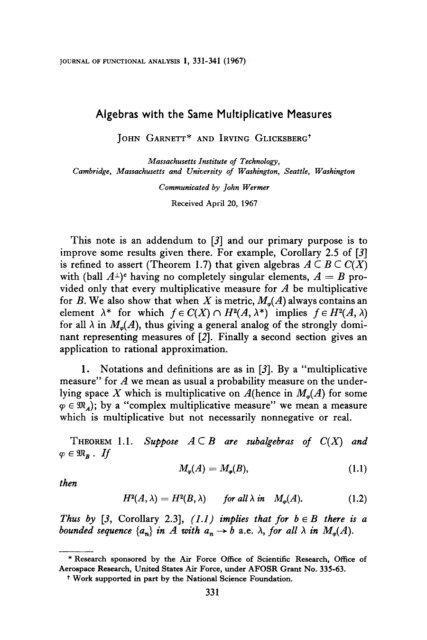On the Characters and the Plancherel Formula of Nilpotent Groups ...
On the Characters and the Plancherel Formula of Nilpotent Groups ...
On the Characters and the Plancherel Formula of Nilpotent Groups ...
Create successful ePaper yourself
Turn your PDF publications into a flip-book with our unique Google optimized e-Paper software.
JOURNAL OF FUNCTIONAL ANALYSIS 1, 331-341 (1967)<br />
Algebras with <strong>the</strong> Same Multiplicative Measures<br />
JOHN GARNETT* AND IRVING GLICKSBERG+<br />
Massachusetts Institute <strong>of</strong> Technology,<br />
Cambridge, Massachusetts <strong>and</strong> University <strong>of</strong> Washington, Seattle, Washington<br />
Communicated by John Wermer<br />
Received April 20, 1967<br />
This note is an addendum to [3] <strong>and</strong> our primary purpose is to<br />
improve some results given <strong>the</strong>re. For example, Corollary 2.5 <strong>of</strong> [3]<br />
is refined to assert (Theorem 1.7) that given algebras A C B C C(X)<br />
with (ball A-L)” having no completely singular elements, A = B pro-<br />
vided only that every multiplicative measure for A be multiplicative<br />
for B. We also show that when X is metric, M,(A) always contains an<br />
element A* for which f E C(X) n H2(A, A*) implies f E H2(A, A)<br />
for all X in M,(A), thus giving a general analog <strong>of</strong> <strong>the</strong> strongly domi-<br />
nant representing measures <strong>of</strong> [2]. Finally a second section gives an<br />
application to rational approximation.<br />
1. Notations <strong>and</strong> definitions are as in [3]. By a “multiplicative<br />
measure” for A we mean as usual a probability measure on <strong>the</strong> under-<br />
lying space X which is multiplicative on A(hence in M,(A) for some<br />
9 E Vtm,); by a “complex multiplicative measure” we mean a measure<br />
which is multiplicative but not necessarily nonnegative or real.<br />
THEOREM 1 .l. Suppose A C B are subalgebras <strong>of</strong> C(X) <strong>and</strong><br />
vE);mg* If<br />
%(4 = Jf,(W, U-1)<br />
<strong>the</strong>n<br />
EP(A, A) = W(B, A) fm all h in M,(A). U-2)<br />
Thus by [3, Corollary 2.31, (1.1) implies that for b E B <strong>the</strong>re is a<br />
bounded sequence {a,} in A with a, -+ b a.e. A, for all h in M,(A).<br />
* Research sponsored by <strong>the</strong> Air Force Office <strong>of</strong> Scientific Research, Office <strong>of</strong><br />
Aerospace Research, United States Air Force, under AFOSR Grant No. 335-63.<br />
+ Work supported in part by <strong>the</strong> National Science Foundation.<br />
331

















